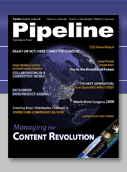|
|

article
page | 1 | 2 | 3 | 4 |
of existing, products. Companies can therefore maintain a “long tail” of products in their portfolio, since products can quickly be customized for many different markets. Rapid product assembly supports two important corporate goals: faster time-to-market and increased revenue generation from a broad product portfolio.
The end goal of many CSPs is to put product creation into the hands of end-users, with the customers themselves specifying the components they would like assembled, or, to use a term from the Web 2.0 movement, “mashed up” into their own, personalized products. Such user empowerment supports the further corporate goal of improving the customer experience, increasing customer “stickiness”, or loyalty.
|
|
Rapid product assembly supports two important corporate goals: faster time-to-market and increased revenue generation from a broad product portfolio. |
|

- case of next generation network services, service logic and supporting network elements can be modeled as separate reusable components.
- IT applications, which are increasingly SOA/Web services based. Applications written as Web services are inherently easy to model as components.
- External content from professional third party sources, such as ringtones, video streams.
- User-generated, “Web 2.0” content.
|
|
|
|

The concept of rapid product assembly is an important contributor to business agility and the business case has been proven over the past decade in different industry sectors including defense, automotive and electronics/IT. Companies such as Dell Computers have demonstrated the power of a rapid product assembly capability in the physical world, while the concept is being applied in the virtual world by Internet companies, including Amazon and Google. Rapid product assembly is now under evaluation by leading communications services providers.
Implications of Rapid Product Assembly for Operational Systems
Rapid product assembly requires CSPs be able to model internal and external services as reusable components that can be assembled together into products. CSPs are identifying four types of product components that they would like to include in rapid product assembly:
- Network services, both legacy and next generation services. The latter are likely to be decoupled from the network in an application layer. The former will be tightly bound to the network resources they run on. In the
|
|

The discovery and specification of which components should be assembled into new products is only one aspect of a rapid product assembly process. While operators may be able to create new services quickly in this way, unless they can also deliver such composite products, on demand, to customers, the concept will fail in its objectives of accelerating time to revenue and developing the customer relationship. Preparing the operational systems, and especially the fulfillment system, to support rapid product assembly is as important as re-engineering the operator’s service creation process.
When a customer orders a product, possibly personalizing all its constituent parts (product components) through a web portal, every component in the product will need to be provisioned. Compared to provisioning a single communications service, such as voice or a broadband connection, the provisioning activity facing operators in the past, fulfilling a next generation assembled product is a considerably more challenging process. The fulfillment system will need an overview of all the components that make up the product and the ability to decompose the product into its constituent components, coordinating
article
page | 1 | 2 | 3 | 4 | |
|
|



